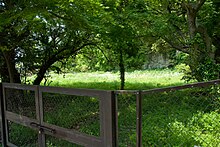|
Tōshō-ji
Tōshō-ji (東勝寺) was the Hōjō clan's family temple (bodaiji) in Kamakura during the Kamakura period.[1] Its founder was Taikō Gyōyū and it was constructed in 1237 by Hōjō Yasutoki in memory of his mother, who had her tomb there.[2] According to the Taiheiki, from its foundation until the end of the Kamakura shogunate every regent (shikken) was buried there.[2] The temple no longer exists, since it was set on fire by the Hōjō themselves when the entire family committed suicide after Nitta Yoshisada's invasion of Kamakura on July 4, 1333.[2][3] Its ruins were found in the Kasaigayatsu valley in today's Ōmachi.[2] Tōshō-ji very probably used to occupy the entire valley.[2] Standing at the top of a narrow valley shut off at its base by the Nameri river's deep gorge and by steep hills on the other three sides, and besides offering a clear view of the only road that crossed the river, it was a fortress surely valuable to the family also from the military point of view.[2] At the site is a plaque that reads:[4]
Excavations in situ have revealed the basic structure of the temple, shards of Chinese pottery, and roof tiles bearing the Hōjō family crest.[2] Stones and other surfaces singed by fire were also found, confirming the presence of a fire.[2]  About a hundred meters uphill after the temple, inside the forest lies the Hōjō Takatoki Harakiri Yagura, the cave where, according to tradition, the last of the Hōjō regents disemboweled himself.[2] There are however other locations in Kamakura that make the same claim. The black stele in front of Takatoki's yagura reads:.[5]
Ashikaga Takauji, the first of the Ashikaga shōguns, was ordered by Emperor Go-Daigo to transfer the temple and the Hōjō's remains to a new location, renaming it Hōkai-ji.[6] Because the neighborhood was said to be still haunted by the ghosts of the Hōjō, a shrine called Tokusō Gongen was erected within the new temple to placate them.[6] The shrine still exists and can be seen to the right of Hōkai-ji's main hall.[6] On the Shakadōgayatsu side of the Shakadō Pass, just before the first houses, a small street to the left takes to a large group of yagura called Shakadōgayatsu Yagura-gun.[7] There rest the bones of some of the Hōjō who killed themselves at Tōshō-ji that day.[7] Their identity has been confirmed by the presence of a gorintō dated exactly eight days after the invasion, eight days being the time required by Buddhism before a funeral can be performed.[7] Notes
References
|
||||||||||||||||||||
Portal di Ensiklopedia Dunia
